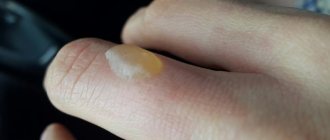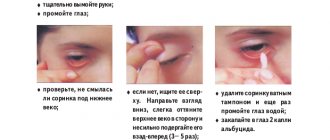When the eyes are burned with lime (calcium carbide), a person receives serious chemical injury to the eyes, accompanied by tissue damage. The main reason for getting such a burn is non-compliance with safety precautions, careless attitude to working with lime, as well as eye damage during accidents. People can encounter hazardous substances both at home and at work.
The severity of the consequences of a chemical burn depends on how professionally emergency assistance is provided to the victim, because the organ of vision has increased sensitivity. If the correct actions are not taken in a timely manner, a person may remain disabled, losing the ability to see completely. Vision is very important for every person. Thanks to our eyes, we not only receive information about the objects around us, but also perceive colors and get joy from life.
In case of eye burns with lime (calcium carbide), small granules of powder fall on the tissues of the eyeball and lead to their rapid destruction. Therefore, it is important to be able to react correctly to a problematic situation in the first minutes. In the article we will tell you in detail how to properly provide emergency assistance to an injured person, what stages of burns exist, and how to further treat vision after such an injury.
Why can't you hesitate?
When lime gets into the area of the eyeball, it is initially difficult to diagnose the degree of destructive effects on eye tissue. This is due to the fact that such a lesion initially looks small. After providing first aid, a person thinks that he has completely dealt with the problem. But this is not true at all. A chemical burn to the eye can lead to serious visual impairment and defects in the eye tissue. Thus, perforation of the cornea may occur, which can lead to atrophic changes in the tissues of the organ of vision.
Even after correctly provided first aid, it is imperative to contact emergency medical services as soon as possible to continue treatment procedures, so that the burn does not affect the deep tissues of the eye and lead to complete blindness.
Hydrogen peroxide gets into your eye: what to do?
Regardless of the volume and concentration of peroxide, the first thing to do is to thoroughly rinse the affected organ of vision with plenty of water. This manipulation will remove the substance from the mucous membrane. The next step is to relieve symptoms and prevent the development of complications. To do this, after copious rinsing, it is recommended to instill drops of Levomycetin or Lidocaine. Ophthalmologists do not recommend using similar ointments, since if the mucous membrane of the eye is burned, increased lacrimation may occur, which will complicate the use of a creamy medicine.
In case of a chemical burn of the organs of vision, drops of "Levomycetin" help relieve irritation and prevent the development of an infectious process in the damaged area of the mucous membrane or cornea. This medicine has soothing and antibacterial properties. Lidocaine drops are a local anesthetic (painkiller). 5-10 minutes after instillation, they have a tonic effect on the optic nerve and soften damaged areas. As a rule, this remedy is prescribed for deep tissue damage. It allows you to relieve acute pain and prevent the development of complications. The drops are instilled under the eyelid, after which it is recommended to take a horizontal position, close the eyelid and cover the eye with a dry cloth.
Upon completion of these manipulations, you should seek help from a doctor as quickly as possible to evaluate the lesion. After the examination, the specialist will formulate a course of treatment aimed at restoring the health of the visual organs. You should not delay going to the doctor, even if hydrogen peroxide gets into your eyes with a low concentration, since each person’s visual system reacts differently to the irritant. It is worth noting that long-term use of medications, including Levomycetin or Lidocaine drops, is prohibited without a doctor’s prescription.
The ophthalmologist must select the required dosage, course duration and treatment regimen.
To quickly provide first aid if hydrogen peroxide somehow gets into your eyes, you can use these products once. It should be borne in mind that their use is contraindicated for children and pregnant women.
First aid after injury
Let's look at how to act in case of eye burns with lime (calcium carbide) in the first minutes after injury.
The first step is to carefully remove the pieces of powder using a cotton swab. It is best if several people participate in providing assistance to the victim, since it is quite difficult for one person to cope with the task. One assistant should pull back the eyelid, and the other should carefully clean out all the lime particles. You can simply pull the lower eyelid down, and try to bend the upper eyelid in the opposite direction (turn it out).
Many people are interested in the answer to the question of whether it is allowed to wash eye burns with lime with water. Some articles on the Internet recommend rinsing immediately with water. But this absolutely cannot be done. Everyone knows how lime reacts when mixed with water. When water is added to a bucket of lime, the mixture begins to foam and boil, and the temperature rises significantly. This can be easily checked by touching a metal bucket with your hand. This is well known to gardeners who treat trees with lime against pests in the spring.
If you start washing your eyes before removing lime particles, a chemical reaction will occur, and a violent reaction will occur, which will only worsen the situation. Remember! First you need to remove all pieces of lime with a cotton swab and only then rinse your eyes under running water. If your eyes hurt after welding, we recommend reading what to do next in the article: https://fb.ru/article/97666/uu-bolyat-glaza-ot-svarki-chto-delat-v-domashnih-usloviyah.
Welding and chemical burns
During electric welding, a dazzling, excessively saturated ultraviolet light is produced, which is harmful to the eyes. Therefore, when people neglect protective glasses and devices, after 6-8 hours the eyes become inflamed, lacrimation, pain, and burning begin. In mild cases, the victim can help himself: apply a cold compress to the eyes for at least an hour. It is useful to drop any fat into the eyes: Vaseline oil, fish oil, even cream. On a bright sunny day, protect your eyes from ultraviolet rays with glasses with smoky or colored glasses - green, blue, yellow.
It is extremely important to follow safety rules for those agricultural workers who deal with mineral fertilizers and other chemicals. Caustic liquids should be poured only using siphons and other devices, transported in unbreakable, hermetically sealed containers, and use lightweight safety goggles and plastic side shields. To prevent the glass from sweating, the inside is covered with a layer of soap suds and wiped dry.
Some chemicals contain compounds that are very dangerous to the eyes. Acids act very quickly, immediately affecting the area they hit. Alkali is more insidious - its effect is not limited to the point of contact, but spreads deeper. It happens that at first the condition of the eye does not cause serious concern, it seems that the damage is very minor, but later, sometimes even on the 8-10th day, vision decreases or the person goes completely blind.
First aid for eye damage is as follows. Immediately after chemicals containing acids or alkalis get into your eye, rinse your eye for 10-15 minutes under running clean water from a tap, drinking fountain, or simply pour water from any clean vessel. And hurry to the doctor.
Similar to the effects of chemical burns on the eye are thermal burns, caused, for example, by hot liquid. For minor burns of the eyelids, it is enough to lubricate them with Vaseline oil or fish oil. In case of significant burns of the eyelids or mucous membrane of the eye, you should immediately consult a doctor.
Stages of a chemical burn to the eye
Experts distinguish 4 stages of damage to the eyeball in burns of this kind, which have varying degrees of severity and depth of penetration into the eye tissue.
Let's look at them briefly:
- Easy stage. Minor epithelial disturbances are visible on the eye. There is redness of the mucous membrane and swelling is noticeable.
- Moderate weight. The chemical burn affected the surface of the skin around the eyeball and the cornea. Blisters from the burn grow around the eyes, and a film or erosive lesions of integrity are formed on the cornea.
- Severe damage is accompanied by necrosis of the deep layers of the eyeball, white or yellowish scabs appear. The layer of the cornea becomes not transparent, but matte. Severe swelling of the skin around the eye forms, and damage to the cornea and conjunctiva is visible.
- Particularly difficult stage. A severe burn leads to necrosis of all tissues adjacent to the eye. These are deep lesions of the cornea, sclera and conjunctiva. The scabs already have a darker color, from grayish to brown. The cornea in this case resembles porcelain.
Symptoms
An eye burn, even the slightest, does not go away without a trace, in which case the following symptoms are observed:
- Intense pain syndrome;
- Photophobia;
- Blepharospasm;
- Swelling of the conjunctiva and cornea;
- lacrimation;
- Redness of the skin of the eyelids;
- Red or white spots on the eyeball;
- Inflammation of the vessels of the membrane;
- Increased intraocular pressure;
- Cloudiness of the cornea;
- Changing the field of view.
It is worth knowing that many symptoms do not appear immediately; the intensity of their formation may increase within 8 hours after the injury. To eliminate them, timely pre-hospital emergency care is needed for eye burns.
The main symptoms of burn injuries to the eye include swelling and redness of the skin of the eyelid, pain and irritation of the eyeball, swelling of the mucous membrane, fear of light, clouding of the cornea, deterioration of vision and a decrease in its field.
Intraocular pressure also decreases or increases. Signs of an eye burn may vary depending on the extent of the damage and the time that has passed since the injury.
For severe damage, a characteristic symptom is necrotization of the conjunctiva and exposure of the sclera. A burn to the cornea of the eye causes lacrimation and blepharospasm.
Chemical burns with a deep degree of injury lead to perforation of the cornea and complete destruction of the eye. Also, not only the eyes, but also other organs can be affected, therefore, the further prognosis for the recovery of the victim depends on how quickly medical assistance is provided.
The very first and “harmless” signs of a chemical burn are redness of the mucous membrane and burning, as well as blepharospasm (the patient cannot open his eyes).
Typical symptoms for chemical burns of any origin are:
- photophobia;
- blurred vision;
- decreased visual acuity;
- swelling of the eye;
- change in color of the cornea and mucous membrane;
- paleness of the cornea of the eye;
- the appearance of scars over time.
Sometimes, as a consequence of a chemical burn, cataracts or glaucoma can develop, and even after taking all therapeutic measures, gradual and inevitable death of the eyeball (subatrophy) can occur.
But you can also get such an injury at home (for example, when doing eyelash extensions or getting household detergents or alcohol in your eyes).
Treatment of burns with lime
In case of eye burns from lime (calcium carbide), after providing first aid, it is imperative to go to the hospital within a few hours; it is best to call an ambulance so that delivery is quick. Typically, doctors hospitalize such a victim in the inpatient department of the hospital for further monitoring of the patient’s condition.
If the burn was received at a chemical plant, then the first aid kit should have a container with a 3% solution of disodium salt of ethylenediaminetetraacetic acid, which is briefly called Na2 EDTA. This solution binds calcium cations, and the resulting mixture is easily washed away with water during the first day.
In the hospital, the burned skin of the eyelids is lubricated with substances such as 10% sulfacyl sodium ointment or 10% sulfapyridazine sodium ointment, 1-5% synthomycin emulsion or 1% erythromycin, tetracycline ointment or sterile fish oil. Also, such ointments can be placed under the eyelids of the affected eye.
Antihistamines are prescribed to help restore visual function of the eye. It is recommended to wash your eyes several times a day with distilled water or tea infusion.
If spasms are present, then drops of atropine are applied to the area of the conjunctival sac. Sometimes intramuscular injections are given. In mild forms of the lesion, the patient is kept in a hospital for only a couple of days for observation and then discharged under the supervision of a local ophthalmologist.
Sugar will help get rid of lime in the eye.
If you get lime in your eyes, but you cannot immediately go to an ophthalmologist, use a simple but effective means for washing the mucous membranes. To prepare it you will need pure distilled water and sugar. Prepare a very strong sweet solution - 1 tbsp. water 1.2 tbsp. Sahara. Rinse your eyes generously with this liquid.
Sugar can completely neutralize the negative effects of lime. Immediately after the procedure, the victim will feel significant relief - the pain will disappear and the inflammation will decrease.
Such injuries are very dangerous, as they can lead to partial or complete loss of vision. Take care of your health, and under no circumstances refuse qualified medical care. Timely first aid will help the victim maintain visual acuity and reduce the spread of a chemical burn.
Prevention
Eye burns caused by lime (calcium carbide) require long-term treatment and specialist supervision, so it is advisable to take precautions to avoid such injury.
Keep the lime in a closed container and be sure to label it so everyone knows what kind of powder it contains. Wear safety glasses before use, and after use, remove all remaining substances to a safe place. Take care of yourself!
Varieties and symptoms
Eye burns vary in severity of damage to the eyeball. There are 4 such degrees in ophthalmology:
- Mild (I) occurs in the presence of hyperemia of the eyelid and conjunctiva, swelling of the cornea. At this degree, the symptoms will disappear on their own without additional treatment.
- The second degree of damage, also known as medium, occurs when the upper layers of the eyelid are damaged, with the presence of swelling and moderate necrotization of the conjunctiva. The epithelial tissue and stroma of the cornea are damaged. Blisters appear on the skin of the eyelids.
- A severe degree of damage is determined when the victim has necrosis of the conjunctiva, eyelid, sclera and cartilage. The cornea becomes dry and cloudy, and the conjunctiva becomes like a yellow or whitish-gray matte scab. For this stage, the burn should not affect more than half the surface of the eye. When the scab begins to be rejected, scarring occurs in the mucous membrane of the eye and cornea.
- A particularly severe degree of damage (IV) is characterized by a deep burn of the mucous membrane and sclera with charring and a necrotic state. The cornea becomes like a white porcelain plate due to deep damage. To this extent, cataracts, secondary glaucoma and uveitis can develop.
The process of treating an eye burn can be divided into 4 stages:
- The first stage takes place within 2 days after the injury, and is characterized by an increase in tissue necrobiosis, swelling of the cornea, and breakdown of protein-polysaccharide complexes.
- The second stage lasts from 2 to 18 days and is characterized by the development of fibrinoid swelling of the cornea.
- The third stage lasts from 2 to 3 months. It is characterized by trophic disorders and tissue hypoxia.
- The fourth stage consists of scarring and increased synthesis of collagen proteins of the cornea. It can drag on for several years.
Immediately after injury, it is very difficult to assess the severity and extent of the injury, which depends on the time of exposure of the eye to the harmful factor. Correct and fully provided first aid is very important for further treatment.
With a stage 3 or 4 eye burn, there is a very high risk of a dangerous consequence - loss of visual function.
Depending on where exactly the violation was localized, the burn may spread to the conjunctiva, eyelids, or cornea. Depending on the severity of the disease, there are 4 degrees.
It is quite difficult to accurately diagnose it in the near future after the incident. This is due to the fact that at first the damage seems minor, but after a few days serious consequences begin.
Perforation of the cornea, changes in it and complete atrophy of the eye may occur.
Therefore, in case of eye burns with lime (calcium carbide), urgent medical attention will be required before visiting a doctor, after which the patient will be urgently taken to the nearest trauma center.
Stages of tissue damage
Depending on how strongly the chemical has affected the tissues of the eye apparatus, the patient may experience certain symptoms. Common manifestations include high sensitivity to light, decreased visual acuity, tissue swelling, redness of the mucous membrane and severe spasm.
Eye burn with lime (calcium carbide): what needs to be done
An eye burn with lime (calcium carbide) is a type of chemical burn of the eyes, which is accompanied by tissue damage.
Burn injury to the eye is a consequence of non-compliance with safety rules. Regardless of what substance it is caused by, you must immediately rinse your eyes with plenty of boiled water and apply a sterile bandage. After this, you need to call an ambulance. An eye burn is more dangerous than damage to the skin. The human organ of vision is characterized by increased sensitivity and tenderness. If there is a delay in providing emergency assistance, a person may lose his sight and remain disabled for life. We receive most of the information about the world around us using a visual analyzer. If its function is impaired, a person not only loses his ability to work, but also the ability to perceive all the colors of the world around him. He will not be able to read, watch movies, admire works of art or nature.
When a lime burn occurs, pieces of calcium carbide enter the tissue of the eyeball. Their rapid destruction occurs, which leads to irreparable consequences. It is important to provide competent first aid in the first minutes after an injury at the scene of an accident.
For eye burns caused by lime and calcium carbide, it is necessary to
When the eyes are burned with lime (calcium carbide), a person receives serious chemical injury to the eyes, accompanied by tissue damage. The main reason for getting such a burn is non-compliance with safety precautions, careless attitude to working with lime, as well as eye damage during accidents. People can encounter hazardous substances both at home and at work.
The severity of the consequences of a chemical burn depends on how professionally emergency assistance is provided to the victim, because the organ of vision has increased sensitivity. If the correct actions are not taken in a timely manner, a person may remain disabled, losing the ability to see completely. Vision is very important for every person. Thanks to our eyes, we not only receive information about the objects around us, but also perceive colors and get joy from life.
In case of eye burns with lime (calcium carbide), small granules of powder fall on the tissues of the eyeball and lead to their rapid destruction. Therefore, it is important to be able to react correctly to a problematic situation in the first minutes. In the article we will tell you in detail how to properly provide emergency assistance to an injured person, what stages of burns exist, and how to further treat vision after such an injury.











